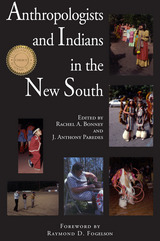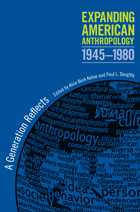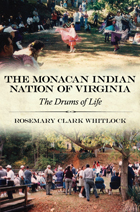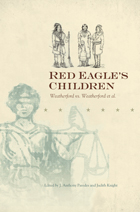4 books about Paredes, J. Anthony

Anthropologists and Indians in the New South
Edited by Rachel Bonney and J. Anthony Paredes; Foreword by Raymond D. Fogelson
University of Alabama Press, 2001
Choice Outstanding Academic Title for 2002
A clear assessment of the growing mutual respect and strengthening bond between modern Native Americans and the researchers who explore their past
Southern Indians have experienced much change in the last half of the 20th century. In rapid succession since World War II, they have passed through the testing field of land claims litigation begun in the 1950s, played upon or retreated from the civil rights movement of the 1960s, seen the proliferation of “wannabe” Indian groups in the 1970s, and created innovative tribal enterprises—such as high-stakes bingo and gambling casinos—in the 1980s. The Native American Graves Protection and Repatriation Act of 1990 stimulated a cultural renewal resulting in tribal museums and heritage programs and a rapprochement with their western kinsmen removed in “Old South” days.
Anthropology in the South has changed too, moving forward at the cutting edge of academic theory. This collection of essays reflects both that which has endured and that which has changed in the anthropological embrace of Indians from the New South. Beginning as an invited session at the 30th-anniversary meeting of the Southern Anthropological Society held in 1996, the collection includes papers by linguists, archaeologists, and physical anthropologists, as well as comments from Native Americans.
This broad scope of inquiry—ranging in subject from the Maya of Florida, presumed biology, and alcohol-related problems to pow-wow dancing, Mobilian linguistics, and the “lost Indian ancestor” myth—results in a volume valuable to students, professionals, and libraries. Anthropologists and Indians in the New South is a clear assessment of the growing mutual respect and strengthening bond between modern Native Americans and the researchers who explore their past.
A clear assessment of the growing mutual respect and strengthening bond between modern Native Americans and the researchers who explore their past
Southern Indians have experienced much change in the last half of the 20th century. In rapid succession since World War II, they have passed through the testing field of land claims litigation begun in the 1950s, played upon or retreated from the civil rights movement of the 1960s, seen the proliferation of “wannabe” Indian groups in the 1970s, and created innovative tribal enterprises—such as high-stakes bingo and gambling casinos—in the 1980s. The Native American Graves Protection and Repatriation Act of 1990 stimulated a cultural renewal resulting in tribal museums and heritage programs and a rapprochement with their western kinsmen removed in “Old South” days.
Anthropology in the South has changed too, moving forward at the cutting edge of academic theory. This collection of essays reflects both that which has endured and that which has changed in the anthropological embrace of Indians from the New South. Beginning as an invited session at the 30th-anniversary meeting of the Southern Anthropological Society held in 1996, the collection includes papers by linguists, archaeologists, and physical anthropologists, as well as comments from Native Americans.
This broad scope of inquiry—ranging in subject from the Maya of Florida, presumed biology, and alcohol-related problems to pow-wow dancing, Mobilian linguistics, and the “lost Indian ancestor” myth—results in a volume valuable to students, professionals, and libraries. Anthropologists and Indians in the New South is a clear assessment of the growing mutual respect and strengthening bond between modern Native Americans and the researchers who explore their past.
[more]

Expanding American Anthropology, 1945-1980
A Generation Reflects
Edited by Alice Beck Kehoe and Paul L. Doughty
University of Alabama Press, 2012
Expanding American Anthropology, 1945–1980: A Generation Reflects takes an inside look at American anthropology’s participation in the enormous expansion of the social sciences after World War II. During this time the discipline of anthropology itself came of age, expanding into diverse subfields, frequently on the initiative of individual practitioners. The Association of Senior Anthropologists of the American Anthropological Association (AAA) called upon a number of its leaders to give accounts of their particular innovations in the discipline. This volume is the result of the AAA venture—a set of primary documents on the history of American anthropology at a critical juncture.
In preparing the volume, the editors endeavored to maintain the feeling of “oral history” within the chapters and to preserve the individual voices of the contributors. There are many books on the history of anthropology, but few that include personal essays from such a broad swath of different perspectives. The passing of time will make this volume increasingly valuable in understanding the development of American anthropology from a small discipline to the profession of over ten thousand practitioners.
[more]

The Monacan Indian Nation of Virginia
The Drums of Life
Rosemary Clark Whitlock, with foreword by J. Anthony Paredes and introduction by Thomas J. Blumer
University of Alabama Press, 2008
The contemporary Monacan Nation had approximately 1,400 registered members in 2006, mostly living in and around Lynchburg, Virginia, in Amherst County, but some are scattered like any other large family. Records trace the Monacans of Virginia back to the late 1500s, with an estimated population of over 15,000 in the 1700s.
Like members of some other native tribes, the Monacans have a long history of struggles for equality in jobs, health care, and education and have suffered cultural, political, and social abuse at the hands of authority figures appointed to serve them. The critical difference for the Monacans was the actions of segregationist Dr. Walter A. Plecker, Director of the Bureau of Vital Statistics from 1912 until he retired at age 85 in 1946. A strong proponent and enforcer of Virginia’s Racial Integrity Law of 1924 (struck down in 1967), which prohibited marriage between races, Plecker’s interpretation of that law convinced him that there were only two races–white and colored–and anyone not bearing physically white genetic characteristics was “colored” and that included Indians. He would not let Indians get married in Virginia unless they applied as white or colored, he forced the local teachers to falsify the students’ race on the official school rolls, and he threatened court clerks and census takers with prosecution if they used the term “Indian” on any official form. He personally changed government records when his directives were not followed and even coerced postpartum Indian mothers to list their newborns as white or colored or they could not take their infants home from the hospital. Eventually the federal government intervened, directing the Virginia state officials to begin the tedious process of correcting official records. Yet the legacy of Plecker’s attempted cultural genocide remains. Through interviews with 26 Monacans, one Episcopal minister appointed to serve them, one former clerk of the court for Amherst County, and her own story, Whitlock provides first person accounts of what happened to the Monacan families and how their very existence as Indians was threatened.
[more]

Red Eagle's Children
Weatherford vs. Weatherford et al.
Edited by J. Anthony Paredes and Judith Knight
University of Alabama Press, 2012
Red Eagle’s Children presents the legal proceedings in an inheritance dispute that serves as an unexpected window on the intersection of two cultural and legal systems: Creek Indian and Euro-American.
Case 1299: Weatherford vs. Weatherford et al. appeared in the Chancery Court of Mobile in 1846 when William “Red Eagle” Weatherford’s son by the Indian woman Supalamy sued his half siblings fathered by Weatherford with two other Creek women, Polly Moniac and Mary Stiggins, for a greater share of Weatherford’s estate. While the court recognized William Jr. as the son of William Sr., he nevertheless lost his petition for inheritance due to the lack of legal evidence concerning the marriage of his biological mother to William Sr. The case, which went to the Alabama Supreme Court in 1851, provides a record of an attempt to interrelate and, perhaps, manipulate differences in cultures as they played out within the ritualized, arcane world of antebellum Alabama jurisprudence.
Although the case has value in the classic mold of salvage ethnography of Creek Indian culture, Red Eagle’s Children, edited by J. Anthony Paredes and Judith Knight, shows that its more enduring value lies in being a source for historical ethnography—that is, for anthropological analyses of cultural dynamics of the past
events that complement the narratives of professional historians.
events that complement the narratives of professional historians.
Contributors
David I. Durham / Robbie Ethridge / Judith
Knight / J. Anthony Paredes / Paul M. Pruitt
Jr. / Nina Gail Thrower / Robert Thrower /
Gregory A. Waselkov
David I. Durham / Robbie Ethridge / Judith
Knight / J. Anthony Paredes / Paul M. Pruitt
Jr. / Nina Gail Thrower / Robert Thrower /
Gregory A. Waselkov
[more]
READERS
Browse our collection.
PUBLISHERS
See BiblioVault's publisher services.
STUDENT SERVICES
Files for college accessibility offices.
UChicago Accessibility Resources
home | accessibility | search | about | contact us
BiblioVault ® 2001 - 2024
The University of Chicago Press









